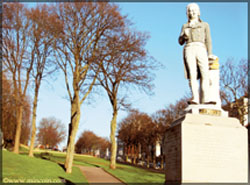|
observer |
|
|
|
|
|
OTHER LINKS |

|

|

|
|
Edward Jenner: Introduced vaccination to the worldVaccines and vaccination are things that we have all heard of and experienced some time during our lives. Vaccination prevents us from catching various diseases by increasing our bodies' resistance to disease-causing substances. Although getting vaccinated is not a pleasant experience, it protects us later in life. Did you know who was responsible for the discovery of this marvel of vaccination? It was none other than Edward Jenner, the English country doctor. He is reputed to be the first doctor to introduce and study the smallpox vaccine.
Jenner was born on May 17, 1749. He loved nature and studied his natural surroundings from childhood. He took an interest in studying medicine and trained in Sodbury, Gloucestershire as an apprentice to a famous doctor for eight years, starting at the age of 13 years. He went to London in 1770 to study under more reputed surgeons at St George's Hospital. It could thus be said that Jenner was noticed by people who had stature(greatness) and standing in the field of medicine from a very early period in his career. Returning to his native countryside around 1773, he set up a general practice at Berkeley, Gloucestershire and became a successful general practitioner and surgeon. He was among other doctors who formed a medical society in Rodborough, Gloucestershire, where they gathered to read papers on medical subjects and have dinner together. He was also a member of another such society which met in Alveston, near Bristol. He was appointed a Fellow of the Royal Society in 1788 after the experiments he conducted into the
previously misunderstood life of the cuckoo in the nest. It had been earlier believed that a cuckoo would plant its eggs in the nest of another bird, and would later push the host's eggs and fledglings from the nest to make room for its own young. Jenner's careful study combining observation, experiment and dissection into this matter found that contrary to popular belief, it was the newly-hatched baby cuckoo that pushed off the other baby birds and the eggs off the nest rather than the adult bird. (This was confirmed only in the 20th century when photography became possible.) In fact, he found that the baby cuckoo has a depression (dent) in its back which it uses to cup eggs and other chicks when pushing them out of the nest. These findings were published in the Philosophical Transactions of the Royal Society in 1787. He married Catherine Kingscote in March 1788. How he met her is an interesting story. Balloons were considered as an important scientific subject those days and Jenner and many of his colleagues used to experiment with them. During one such experiment, his balloon floated into Kingscote Park, which was owned by Anthony Kingscote; Catherine was one of his three daughters. (She died from tuberculosis in 1815.) In 1792, he won his MD from the University of St Andrew's. Around this time, smallpox had become a scourge with 60 per cent of the population catching it, 20 per cent of them dying of it with the survivors being badly disfigured. Jenner had realised by this time that milkmaids didn't catch this dreaded disease. He had figured out that the pus in the blisters which milkmaids had got from cowpox (a disease similar to smallpox, but less dangerous) made them immune to smallpox. Jenner tested his theory in 1796 by injecting a young boy named James Phipps with a substance from the cowpox blisters of the hand of a milkmaid who had caught cowpox. Apart from a fever and some uneasiness, the boy didn't report any other illness. Later, Jenner injected Phipps with smallpox material, and found that he wasn't affected. He realised that being infected with the cowpox virus made one immune to smallpox. (Although a farmer named Benjamin Jesty had successfully immunised his family with cowpox during a smallpox epidemic in 1774, it was only after Jenner's work that the technique became widely understood and used). Jenner went on with his research, reporting the findings to the Royal Society, which did not publish the initial report. It was only many years later that the medical establishment considered his findings and accepted them. His work on vaccination prevented him from continuing with his general practice, but with government grants, he could continue with his work. In 1803, he involved himself with the Jennerian Institution in London, which was promoting vaccination to wipe out smallpox. In 1808, this society became the National Vaccine Establishment, with government aid. He was also a member of the Medical and Chirurgical Society, now the Royal Society of Medicine, since its inception in 1805. He won an MD degree from the University of Oxford in 1813. In 1821, he was appointed Physician Extraordinary to King George IV, and became Mayor of Berkeley and Justice of the Peace. Natural history continued to interest him despite his scientific work and in 1823, he presented the paper 'Observations on the Migration of Birds' to the Royal Society. Jenner died of a stroke (his second), on January 26, 1823. He left a son and a daughter, the eldest son having died of tuberculosis at the age of 21. One of the greatest honours that he was paid was the declaration made by the World Health Organisation in 1980 that smallpox is completely eradicated from this world. Monuments * Jenner's house in Berkeley, Gloucestershire is now a small museum. * Jenner was buried at the parish church of Berkeley. * A statue, by Robert William Sievier, was erected in the nave of Gloucester Cathedral. * A statue was erected in Trafalgar Square; it was later moved to Kensington Gardens. * St George's University, London has a wing named after him as well as a bust. |











